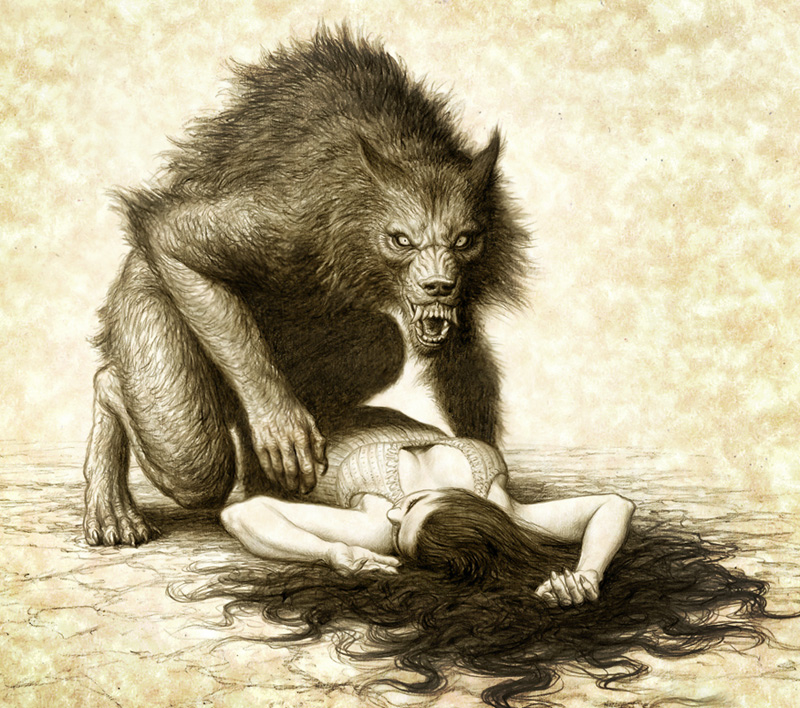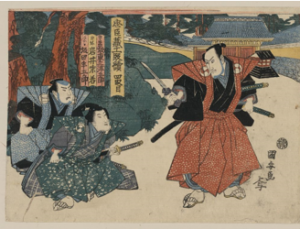Have you ever heard that at night the creatures come out, especially when there is a full moon. But whenever people think of a full moon, the thought of a werewolf might cross their mind. Because of the famous movie Twilight: New Moon, which was released in 2009, people might imagine a werewolf being Taylor Lautner turning into a huge wolf. However, before this movie was released to the big screen, werewolves were thought to be a thing of the night, actual monsters to fear.
In the past, werewolves are said to be the product of a human’s involuntary, typically only temporary, transformation into a wolf.1 They didn’t necessarily completely change into a full wolf, but had the appearance of being half-wolf and half-human. For quite some time during the medieval period, many couldn’t accept the fact that a man could transform into a wolf. They concluded that these werewolves were a product of magic, that witches used their magic to transform someone into a wolf, known as lycanthropy. With the use of magic, these werewolves were considered voluntary werewolves, as oppose to involuntary werewolves, who shifted into wolves because of their sins.2 After the transformation was made, people assumed a werewolf was a servant from the devil himself, and anyone accused of being one was put to death.3

The origins of these beliefs started in the Balkan area. In this region, the Dacians, who were an ancient people, had a wolf as their totem animal. With this being said, they believed that they were able to turn young men into wolves when performing a ritual.4 When this ritual was performed, they would imitate a wolf along with wearing wolf skins; this is because they believed the wolf should be highly respected for being a hunter. Even in Greek mythology, one can find stories about men transforming into a wolf. They told the story that the mighty Zeus became angry at a man named Lycaon, and for a punishment, he turned Lycaon into a wolf. With this story we get the term lycanthropy. However, some people believe that werewolves may be a relic of early cannibalism rather than just beings consulting with the devil. Communities of semicivilized people would begin to shun those who devoured human flesh, ostracizing them and classifying them as wild beasts.5 People who would willingly choose to eat a human being are not really human, but rather a beast, because they behave just as beastly as a wild animal.
The belief of werewolves may seem fictional to us today, but in the 1500’s, these beasts were thought to be completely real. In 1407, Basel Switzerland authorities claimed that they had the first official execution of werewolves, with several individuals being accused, then tortured and burned.6 Werewolf trials then took place in Poligny, France in 1521, when three men claimed they were consulting with demons in order to gain the power to transform into wolves. The men then confessed that they had killed and consumed several children for nineteen years. All three men were then burned at the stake.7

In the following years, many cases of people being werewolves were brought forward. One of the most famous cases was of Gilles Garnier in Dole, France 1573. No one understood why several young children disappeared in 1573, until Garnier and his wife were arrested and tried as werewolves. Garnier confessed that he had killed a twelve year old boy, and was going to consume his flesh, but was interrupted before doing so. Although he was in human form, some citizens claimed that he had appeared as a wolf. In his confession, he claimed to have killed a ten year old girl while being in the shape of a wolf, using his teeth and claws to devour her.8 He also claimed to have attacked a girl but was again interrupted; several days later he strangled a ten year old boy, ripping his leg off and eating his flesh. In both incidents he claimed that he was in wolf form. After all of his confessions, he was then burned alive on January 18, 1574.9

In another known case, a man named Peter Stubbe also claimed to be a werewolf. He possessed a magic belt that allowed him to transform from man to wolf. Although authorities never found his belt, he was beheaded for his crimes in 1589.10
Finding evidence of real werewolves was tricky, until 1598, with the case of Jacques Roulet. A group of hunters stumbled upon two wolves devouring a fifteen year old boy. Since they were armed, the hunters decided to follow the wolves. When following the tracks, the paws slowly started to become more human like. They finally reached the end of the tracks, finding a man with long hair and a long beard, wearing rags, his hands covered in blood, and his long nails contained bits of human flesh. Jacques claimed he had possessed a salve that would enable him to turn into a wolf.11 Although the cases of werewolfism died down, the idea of being a werewolf never disappeared.
Over time, the phenomenon of werewolves took a new shape. In 1935, the movie Werewolf of London opened, introducing a cinematic version of these supernatural beings. The plot of the movie was inspired by the true story of Francis Bertrand. Bertrand had been convicted in 1848 for breaking into several graveyards in Paris. He would dig up recently buried corpses and consume their flesh.12 The story was then transformed into a movie about Bertrand Caullet, a person who didn’t have the knowledge of being a werewolf until being shot with a silver bullet. The silver bullet was significant, as it became a reoccurring theme in later movies, including Frankenstein Meets the Werewolf in 1943, and later in An American Werewolf in Paris in 1997. With the use of the silver bullet, people stepped back from thinking of beheading or burning people at the stake as ways of killing these beasts. The concept of using a silver bullet emerged from the Scottish belief in the efficacy of using silver to kill witches.13 Another modern adaptation that emerged was in the ways one would become a werewolf. In the past, in order for you to transform you needed the help of a witch or magic, but that started to fade. Today popular culture has transformed the original belief into one that sees being bitten or scratched by a wolf or werewolf in order to become a werewolf. The reason for this change started with The Wolf Man film of 1941.
By the 1970’s, werewolves had become very popular in genres of horror: in movies, in books, and even in television shows. With the franchise of werewolves still growing, there are less cases of werewolfism today. Many doctors believe that what people witnessed wasn’t an actual werewolf, but rather a person suffering from a serious mental illness, along with a condition called porphyria. Porphyria causes people’s skin to turn brown and oddly textured. People who suffer from this disease also become sensitive to light, making them more comfortable with venturing out at night.[13. Encyclopedia of Occultism and Parapsychology, 5th ed., 2001, s.v. “Werewolf.”] However, even with the explanation of having porphyria, some still believe in the phenomenon of werewolfism. In one case, a forty-nine year old woman believed that she was a werewolf, even after receiving psychotherapy and antipsychotic drugs. She would be able to control herself until a full moon, but when the full moon arrived, she would behave like a wolf by snarling and howling.14
The perception of what a werewolf is has shifted over time, but judging by its origins, maybe it was for the best that we changed our thoughts of werewolves. Although we may never know if a man can truly turn into a wolf, we can’t stop people from believing in werewolves. The past has been proof that people believe in werewolves regardless whether it seems impossible. Just keep in mind the next time you decide to walk alone at night on a full moon, you never know what creature lurks in the dark of night.
- In Encyclopedia of Occultism and Parapsychology, 5th ed., 2001, s.v. “Werewolf.” ↵
- In The Greenhaven Encyclopedia of Paranormal Phenomena, 2006, s.v. “Werewolves.” ↵
- Encyclopedia of Occultism and Parapsychology, 5th ed., 2001, s.v. “Werewolf.” ↵
- In The Greenhaven Encyclopedia of Paranormal Phenomena, 2006, s.v. “Werewolves.” ↵
- Encyclopedia of Occultism and Parapsychology, 5th ed., 2001, s.v. “Werewolf.” ↵
- The Gale Encyclopedia of the Unusual and Unexplained, Vol. 3., 2003, s.v. “Creatures of the Night.” ↵
- The Gale Encyclopedia of the Unusual and Unexplained, Vol. 3., 2003, s.v. “Creatures of the Night.” ↵
- Encyclopedia of Occultism and Parapsychology, Vol. 1., 5th ed., 2001, s.v. “Garnier, Gilles (d. 1574).” ↵
- Encyclopedia of Occultism and Parapsychology, Vol. 1., 5th ed., 2001, s.v. “Garnier, Gilles (d. 1574).” ↵
- In the Gale Encyclopedia of the Unusual and Unexplained, Vol. 3., 2003, s.v. “Creatures of the Night.” ↵
- The Gale Encyclopedia of the Unusual and Unexplained, Vol. 3., 2003, s.v. “Creatures of the Night.” ↵
- Encyclopedia of Occultism and Parapsychology, 5th ed., 2001, s.v. “Werewolf.” ↵
- Encyclopedia of Occultism and Parapsychology, 5th ed., 2001, s.v. “Werewolf.” ↵
- In the Gale Encyclopedia of the Unusual and Unexplained, Vol. 3., 2003, s.v. “Creatures of the Night.” ↵



103 comments
Carlos Sandoval
Werewolves are probably one of the coolest myths out there, the thought of one is kind of creepy I could not imagine seeing one. I do not know what would drive someone to think another person is a werewolf or that they are, it is comical. This was a very well written article and was helpful in me learning some new information that I lacked to know.
Austin Pena
Great article! The legend of the werewolf is one that i remember reading about as a child, but never thought anything of it. The article did a great job of using real examples of past cases of humans being werewolf’s and thats what i found to be the most interesting. Most will probably say that there nothing more than an urban legend, but who knows.
Maria Mancha
I am a big twilight fan, so this article was so interesting to learn so much about the actual myths of werewolf’s. I always thought that these theories were just the ones your mom told you to keep you from misbehaving. But that there is an actual origin of it and combines which Greek Mythology. Also how its not like twilight where they actually turn into a full grown wolf but they are still combined with human aspects. Lastly I enjoyed your conclusion and how you said that the depiction of them has changed over time from what it really it, I believe that tied your article all together.
Hanadi Sonouper
This article was very fascinating to read, especially because I was a werewolf twilight fanatic. The author gave a lot of in-depth detail as to how the theory and myths of werewolf’s first surfaced, because it concludes that these theories were not just made up from out of the blue. I definitely enjoyed reading about their historical background from the fifteenth and sixteenth century. However, it can also be true that werewolf’s can be just a general label that categorizes individuals with mental illnesses or cannibalistic behaviors, but overall it was a very well written informative article.
Vanessa Tombo
Prior to reading this article, I was unaware of the origin of the werewolf. After arriving in America, that is when I began to hear about the mythical creature. In Kenyan folk and Congolese folk, tales take I had never heard of these creatures. The doctor’s explanation of the creature is very logical. The brain is very capable of distorting images and making one believe false images to be true.
Bryan Martin Patino
Werewolves were always a fantastic wonder to me i was both terrified and astonished by the myth of a werewolf. it was the ability to change your form but at a terrible price of becoming an uncontrollable monster with no recollection of what you did but knowing that you did something terrible when u wake. Reading this i learned that there were some believes that thought it could have by your own accord to be one and therefore have control while in that state, its pretty interesting knowing the different views people had in different parts of the world and the times that they where in.
Hector Garcia
It is fascinating to read about the origins of the werewolves and how they are still popular in today’s culture. My favorite part would definitely have to be that the doctors were able to come up with a theory of how we came up with werewolves. This explanation of how people with suffered from severe mental illness and porphyria seems pretty reasonable explanation.
Timothy ODekirk
The lore of werewolves hooked me in on this article right away. And the title picture of the werewolf and the girl drawn my attention as well. I found it fascinating about how the myth of the werewolf originated and evolved throughout time. I find and interesting and also a little disturbing the fact that people would be put to death in the 1500s for just being accused of being a werewolf. However, what fascinated me the most about this legend is the fact of what really could of been the cause for all of these accusations of wearwovles. Of course, the fact of wearwolfism is almost impossible, and the fact to find out that the accused most likely suffered from porphyia was the most interesting to me. This proves that the legend of the werewolf and wearwolfism is mostly likely to continue to stay a legend.
Jason Garcia
I had grown up believing that werewolves were just legend and myths. I had no idea that people actually thought they were real. I also had no idea that the werewolf mythos changed over time. I had always thought that they only way to kill one was a silver bullet right from the start. I didn’t think that the media had that kind of power then. The article explains the origins of werewolves very well along with the modern interpretation of the legend. Very well done
Arianna Kennet
I never actually knew the history behind werewolves till I read this article. It is interesting how the Dacians was a time where they thought that they could turn young men into werewolves, and how they related it to greek mythology. The story of Garnier was creeped me out a little, where he was found guilty for murdering small kids. An interesting read.